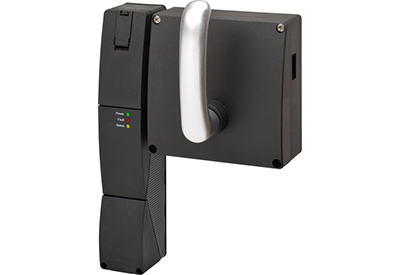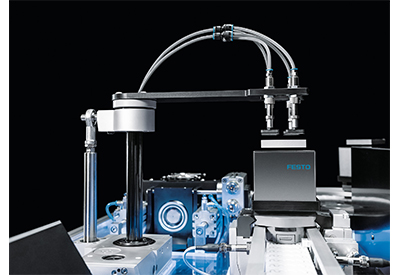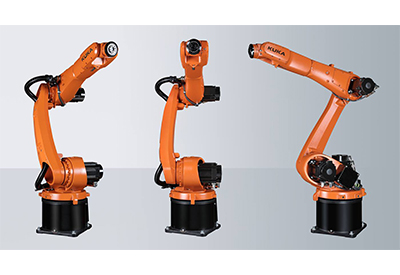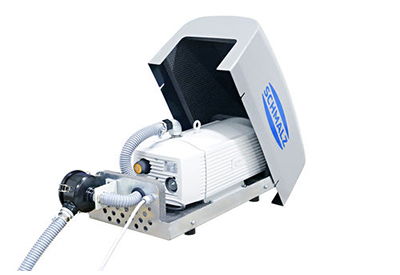Five Ways that OMRON’s D41 Series Door Switch Add Value to Machines

September 14, 2021
One of the major challenges that manufacturers face when designing a safety system is minimizing opportunities for operators to bypass devices like door switches. The possibility of bypassing can lower the safety performance level and perhaps even lead to a loss of compliance. Fortunately, today’s state-of-the-art safety technologies are designed to eliminate safety device defeat and help manufacturers uphold safety best practices. Take a look at how Omron’s new D41 Series safety door switches maximize both safety and uptime for critical machinery.
Non-contact and guard-locking options minimize possibilities
Omron’s RFID-monitored door switches provide non-content and guard-locking options to prevent bypassing and ensure the highest level of operator protection. According to ISO 14119, the D41 Series is considered a Type 4 interlocking device because its position switch is actuated by a coded RFID tag actuator that opens its contacts when the guard is not closed.
Coding creates unique combinations that make the system more difficult to bypass. For actual coding purposes, EN 14119 also introduces a coding level classification that is applicable independently of the technology used. A high-coded safety switch is one where a sensor is paired with a high-level coded actuator offering more than 1,000 variations.
Safety and maintenance teams working on retrofit machinery, preparing to implement a risk reduction strategy, or seeking to follow industry best practices can use Type 4 high-coded door switches to prevent safety device manipulation and keep people safe.
A single product family with multiple options lowers the cost of ownership
Using a single product family prevents unnecessary losses by simplifying the design and installation stages while reducing MRO investments. The D41 Series includes different types of door switches so that both end-users and machine builders can find the ideal option for their design and maintenance activities while keeping stock levels and costs to a minimum.
Machine builders who design compact machines face physical restrictions like limited space or limited tolerance when installing safety door switches. Sometimes, builders try to mount safety devices in hidden positions or out of reach to minimize bypassing. Omron’s door switches support a variety of guarding strategies for different machines.
The D41 D, for example, offers three different types of actuators – including flat and miniature options – to fit any machine design. Other options like the D41 L and D41 G sensors with guard lock capabilities offer an asymmetric structure that fits the aluminum profile and can be combined with different actuators for left and right hinged doors.
For end-users who have found safety door switches to be a base of downtime due to misalignment or poor installation practices (such as using a door switch as a mechanical stop) can take advantage of the D41L’s unique design with increase alignment tolerance. The D41 L can be used as an end stop with no additional parts required and helps customers save money.
They are easy to install and troubleshoot
The D41 Series offers automatic pairing and dramatically reduces the amount of effort required to commission and maintain a machine. All models feature three-colour LED diagnostic outputs that minimize non-value-added activities like resolving door switches misalignment during commissioning or troubleshooting thanks to easy and accessible visualization for diagnostic.
All models offer automatic and quick pairing for one or more switches if connected in series. This speeds up installation and simplifies maintenance when an actuator needs to be replaced. For example. OEMs building machinery with multiple movable guards that need to have door switches connected in series can complete pairing all at once without taking extra time.
They are the ideal option for harsh environments
The D41 L’s unique design prevents the accumulation of water, dust, and food in the device and supports ECOLAB-certified detergent resistance for quick cleaning. This makes it ideal for control engineers looking to meet high hygiene standards and regulations for food processing and packaging machines.
For dusty environments in which frequent additional maintenance efforts are required to maintain door switches, the D41 L offers a new approach that combines RFID with a unique mechanism and no keyholes to prevent foreign matter from collecting on its body.
They keep workers safe around robotic applications
Featuring an ergonomic actuator and supporting compliance with ANSI/RIA 15.06, the D41 G is the ideal complement to any robotic application for keeping personnel away from hazardous areas. It also offers accessories that are familiar to operators on the factory floor.
Overall, the D41 product family makes it possible for workers to quickly exist in dangerous zones by simply pushing out the door while turning the handle. In case of power loss, maintenance teams will be able to mechanically unlock the solenoid.




